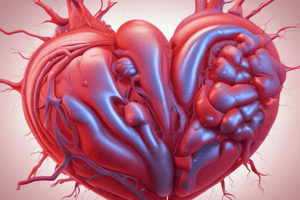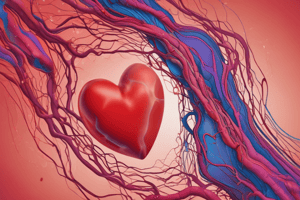Podcast
Questions and Answers
Hypertension is a risk factor for arteriosclerosis.
Hypertension is a risk factor for arteriosclerosis.
True (A)
Arteriolosclerosis affects larger arteries.
Arteriolosclerosis affects larger arteries.
False (B)
High levels of high-density lipoprotein (HDL) cholesterol increase the risk of atherosclerosis.
High levels of high-density lipoprotein (HDL) cholesterol increase the risk of atherosclerosis.
False (B)
Plaque rupture can cause thrombosis, leading to acute coronary syndromes.
Plaque rupture can cause thrombosis, leading to acute coronary syndromes.
Angioplasty or stenting is a diagnostic tool for arteriosclerosis.
Angioplasty or stenting is a diagnostic tool for arteriosclerosis.
Retinopathy is a complication of arteriolosclerosis.
Retinopathy is a complication of arteriolosclerosis.
Smoking decreases the risk of atherosclerosis.
Smoking decreases the risk of atherosclerosis.
Hyperplastic arteriolosclerosis is characterized by the deposition of hyaline material in the arteriolar wall.
Hyperplastic arteriolosclerosis is characterized by the deposition of hyaline material in the arteriolar wall.
Kidney disease is a risk factor for arteriosclerosis.
Kidney disease is a risk factor for arteriosclerosis.
Exercise is a treatment for arteriosclerosis.
Exercise is a treatment for arteriosclerosis.
Study Notes
Definition and Types
- Arteriosclerosis: a chronic inflammatory response that leads to the thickening and hardening of arterial walls, resulting in reduced blood flow to organs and tissues.
- Two main types:
- Atherosclerosis: the most common form, characterized by the buildup of plaque (fatty deposits, cholesterol, and cellular waste) in the inner lining of arteries.
- Arteriolosclerosis: affects smaller arteries, causing thickening of the vessel wall and narrowing of the lumen.
Causes and Risk Factors
- Atherosclerosis:
- High levels of low-density lipoprotein (LDL) cholesterol
- Smoking
- High blood pressure
- Diabetes
- Obesity
- Physical inactivity
- Family history
- Arteriolosclerosis:
- Hypertension
- Diabetes
- Kidney disease
- Aging
Pathophysiology
- Atherosclerosis:
- Fatty streaks form in the intima (innermost layer) of the artery
- Inflammation and immune response lead to the formation of plaque
- Plaque rupture can cause thrombosis, leading to acute coronary syndromes
- Arteriolosclerosis:
- Hyaline arteriolosclerosis: deposition of hyaline material in the arteriolar wall
- Hyperplastic arteriolosclerosis: proliferation of smooth muscle cells and thickening of the vessel wall
Symptoms and Complications
- Atherosclerosis:
- Chest pain (angina) or heart attack (myocardial infarction)
- Stroke or transient ischemic attack (TIA)
- Peripheral artery disease (PAD)
- Arteriolosclerosis:
- Hypertension
- Kidney disease
- Retinopathy
- Cardiovascular disease
Diagnosis and Treatment
- Diagnostic tools:
- Imaging techniques (e.g., ultrasonography, angiography, MRI)
- Blood tests (e.g., lipid profile, blood glucose)
- Treatment:
- Lifestyle modifications (e.g., diet, exercise, smoking cessation)
- Medications (e.g., statins, antihypertensives, antiplatelet agents)
- Angioplasty or stenting
- Bypass surgery
Studying That Suits You
Use AI to generate personalized quizzes and flashcards to suit your learning preferences.
Description
Learn about the definition, types, causes, and diagnosis of arteriosclerosis and atherosclerosis. Understand the risk factors, pathophysiology, symptoms, and treatment options for these cardiovascular diseases.




